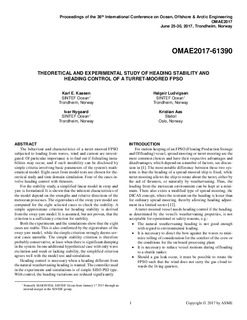| dc.contributor.author | Kaasen, Karl Erik | |
| dc.contributor.author | Ludvigsen, Halgeir | |
| dc.contributor.author | Nygaard, Ivar | |
| dc.contributor.author | Aas, Kristian | |
| dc.date.accessioned | 2017-10-12T06:16:37Z | |
| dc.date.available | 2017-10-12T06:16:37Z | |
| dc.date.created | 2017-10-11T08:36:52Z | |
| dc.date.issued | 2017-06-25 | |
| dc.identifier.citation | ASME 2017 36th International Conference on Ocean, Offshore and Arctic Engineering - Volume 1: Offshore Technology | nb_NO |
| dc.identifier.isbn | 978-0-7918-5763-2 | |
| dc.identifier.uri | http://hdl.handle.net/11250/2459779 | |
| dc.description.abstract | The behaviour and characteristics of a turret-moored FPSO subjected to loading from waves, wind and current are investigated. Of particular importance is to find out if fishtailing instabilities may occur, and if such instability can be disclosed by simple criteria involving basic parameters of the system’s mathematical model. Eight cases from model tests are chosen for theoretical study and time domain simulation. Four of the cases involve heading control with thrusters. For the stability study, a simplified linear model in sway and yaw is formulated. It is shown that the inherent characteristics of the model depend on the strengths and relative directions of the metocean processes. The eigenvalues of the sway-yaw model are computed for the eight selected cases to check the stability. A simple approximate criterion for heading stability is derived from the sway-yaw model. It is assumed, but not proven, that the criterion is a sufficiency criterion for stability. Both the experiments and the simulations show that the eight cases are stable. This is also confirmed by the eigenvalues of the sway-yaw model, while the simple criterion wrongly deems several cases unstable. The simple stability criterion is therefore probably conservative, at least when there is significant damping in the system. In one additional hypothetical case with only wave excitation and weak or lacking stability, the simplified criterion agrees well with the model test and simulation. Heading control is necessary when a heading different from the natural weathervaning heading is wanted. The controller used in the experiments and simulations is of simple SISO PID type. With control, the heading variations are reduced significantly. | nb_NO |
| dc.language.iso | eng | nb_NO |
| dc.relation.ispartof | ASME 2017 36th International Conference on Ocean, Offshore and Arctic Engineering - Volume 1: Offshore Technology | |
| dc.relation.ispartofseries | ASME Proceedings | Offshore Technology;OMAE2017-61390 | |
| dc.subject | Stability | nb_NO |
| dc.subject | FPSO | nb_NO |
| dc.subject | Mooring | nb_NO |
| dc.title | Theoretical and Experimental Study of Heading Stability and Heading Control of a Turret-Moored FPSO | nb_NO |
| dc.type | Chapter | nb_NO |
| dc.description.version | acceptedVersion | nb_NO |
| dc.rights.holder | Copyright © 2017 by ASME | nb_NO |
| dc.identifier.doi | 10.1115/OMAE2017-61390 | |
| dc.identifier.cristin | 1503720 | |
| cristin.unitcode | 7566,8,0,0 | |
| cristin.unitcode | 7566,9,0,0 | |
| cristin.unitname | Ocean Engineering | |
| cristin.unitname | Hydrodynamikk | |
| cristin.ispublished | true | |
| cristin.fulltext | postprint | |
| cristin.qualitycode | 1 | |
